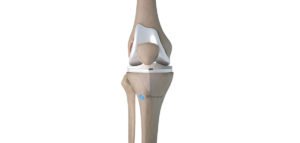When a patient suffers from diffuse osteoarthritis of his knee that is no longer relieved by medical treatments, he is offered a total knee replacement which replaces all of the joint’s cartilage.
While this type of prosthesis gives very good functional results, it remains quite exceptional for a patient with a total knee replacement to completely forget their prosthesis. By comparison, total hip replacement are “forgotten” after a year in about 85% of cases.
Throughout the history of prosthetic knee surgery, we have therefore seen various developments in an attempt to improve the quality of the result and the feeling of prostheses.
Since 2019, a new type of “custom-made” total knee prosthesis has been available. To understand this development, we need to briefly review what “classic” knee replacements are.
Our knees have not all the same size and the wear and tear that leads to a knee replacement does not result in the same degree of deformity in different patients. The fitting of a knee prosthesis will therefore consist in implanting a prosthesis of a size corresponding to that of the “patient’s” knee and the femoral and tibial bone cuts that will allow this implantation will also have to properly realign the knee.
In the case of “classic” knee replacement, specific instrumentation will make it possible to measure the size of the native knee during the operation in order to choose a prosthesis of the corresponding size, the surgeon having in the operating room a wide variety of implant sizes. Preoperative radiological measurements will make it possible to determine the angles with which the bone cuts will be made to realign the knee. These cuts will be made using adjustable instrumentation that is common for all patients.
Subsequently, certain developments have sought to improve the precision of the cutting angles in an attempt to obtain optimal realignment of the knee.
In the early 2000s, we saw the emergence of surgical navigation. A computer and optical sensors present in the operating room make it possible to locate the morphology, axes and plane of rotation of the knee in space in order to determine how the bone cutting guides of the instrumentation must be positioned so that the realignment of the knee is the best possible.
A second evolution appeared about ten years ago with the appearance of personalized cutting guides. Instead of using conventional adjustable instrumentation to perform bone cuts, patient-specific plastic cutting guides are 3D printed ahead of the operation from a CT-scan of the patient’s knee.
The aim of these developments was to improve the precision of cutting angles, but various studies have shown that there is no significant difference with cuts made using conventional instrumentation. To the extent that these changes complicate the preparation or performance of the operation without making any obvious improvement, they have never really taken hold.
Whether for surgical navigation or for custom cutting guides, the knee prosthesis itself does not change. Its design and radii of curvature are the same for all patients. We could compare this to “ready-to-wear”: a prosthesis of the same shape for all but different sizes available. Some have speculated that if some patients had disappointing results and still “felt” their prosthesis, it was because the design of the prosthesis was different from that of their original knee.
We have therefore seen the appearance of “custom-made” knee prostheses since 2019. From a CT-scan of the patient’s knee, a prosthesis is cut to the shape of the patient’s original knee and personalized cutting guides for its implantation are 3D printed.
It is still far too early to say whether this development will improve the quality of the results obtained. For the moment, it is preferable to reserve this type of prosthesis for osteoarthritis responsible for moderate deformities and without associated ligament pathology because the planning does not take into account ligament hyperlaxity likely to pose specific problems that are more easily manageable with a classic knee prosthesis and its adjustable instrumentation.
Personally, I use these prosthesis in certain indications, especially since the industrial process which goes from the realization of the scanner to the manufacture of the prosthesis and the personalized cutting guides and its delivery to the operating room is perfectly reliable. The installation technique is reliable as well. These “custom-made” prosthesis seems to me to represent an interesting development in knee replacement surgery that could improve the functional result, but there is not yet enough hindsight to confirm it. However, this will not solve all the problems because the capacity of the constituent materials of the prosthesis to absorb impacts is different from that of the native knee and it is unfortunately unlikely that these prosthesis will be entirely forgotten.
Discover the operation linked to this article:

Total Knee Replacement
A total knee replacement is proposed in the case of diffuse wear of the knee cartilage when medical treatments no longer relieve the pain and the patient’s ability to get around has deteriorated. This operation aims to eliminate the pain and restore knee function so the patient can walk unrestrictedly and participate in gentle sports activities (walking, golf, cycling, swimming, keep-fit…).

